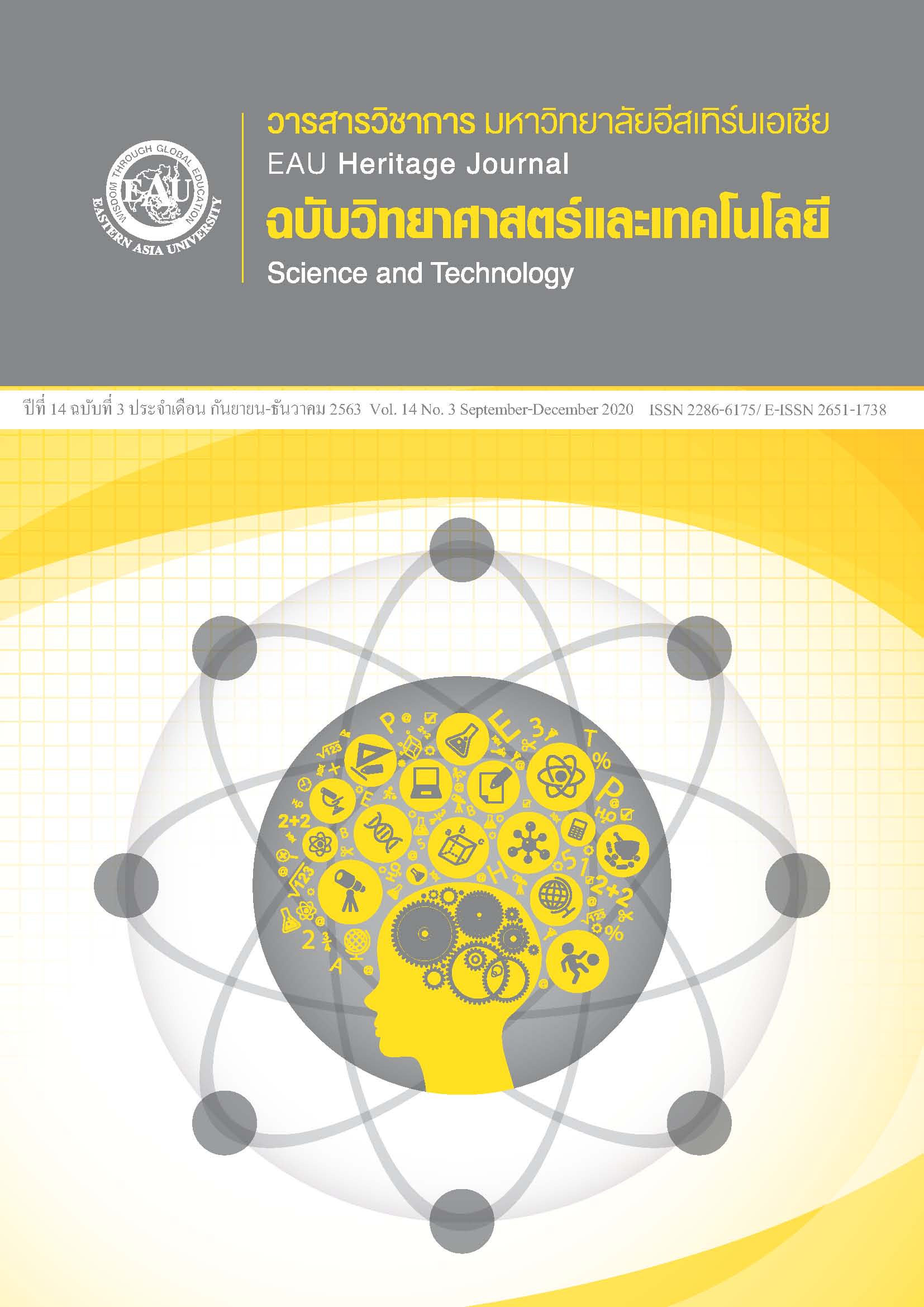ความสัมพันธ์เชิงเหตุผลระหว่างตัวแปรคัดสรรที่มีผลต่อคุณภาพชีวิต ของผู้ป่วยโรคเรื้อรังที่มารับบริการรักษาที่โรงพยาบาลส่งเสริมสุขภาพ ตำบลคลองไทร อำเภอมวกเหล็ก จังหวัดสระบุรี
คำสำคัญ:
คุณภาพชีวิต, ผู้ป่วยโรคเรื้อรัง, โรงพยาบาลส่งเสริมสุขภาพตำบลบทคัดย่อ
การวิจัยครั้งนี้มีวัตถุประสงค์เพื่อ (1) ศึกษาระดับคุณภาพชีวิต พฤติกรรมด้านการบริโภคอาหาร การออกกำลังกาย และการจัดการความเครียดของผู้ป่วยโรคเรื้อรัง (2) วิเคราะห์องค์ประกอบเชิงยืนยันของแต่ละปัจจัยคัดสรรคุณภาพชีวิตของผู้ป่วยโรคเรื้อรัง ตามแบบจำลองสมการโครงสร้าง และ (3) ศึกษาความสัมพันธ์เชิงเหตุผลตามแบบจำลองสมการโครงสร้าง (structural equation model) คุณภาพชีวิตของผู้ป่วยโรคเรื้อรัง กลุ่มตัวอย่าง ได้แก่ ผู้ป่วยโรคเรื้อรังที่มารับบริการรักษาที่โรงพยาบาลส่งเสริมสุขภาพตำบลคลองไทร อำเภอมวกเหล็ก จังหวัดสระบุรี จำนวน 110 คน ได้จากการใช้วิธีการประมาณค่าสัดส่วนของประชากร โดยใช้ตารางของ Krejcie & Morgan คัดเลือกกลุ่มตัวอย่างโดยวิธีการสุ่มแบบเจาะจง (purposive sampling) เก็บข้อมูลโดยใช้แบบสอบถาม มีเนื้อหา 3 ส่วน ได้แก่ (1) คุณลักษณะทางประชากร (2) พฤติกรรม 3 อ. (การบริโภคอาหาร การออกกำลังกาย และการจัดการความเครียด) และ (3) คุณภาพชีวิตของผู้ป่วยโรคเรื้อรังขององค์การอนามัยโลก ค่าสัมประสิทธ์อัลฟ่าของครอนบาคทั้งฉบับเท่ากับ 0.89 วิเคราะห์ข้อมูลด้วยสถิติเชิงพรรณนา และด้วยโปรแกรม LISREL ผลการวิจัยพบว่า (1) คุณภาพชีวิต และปัจจัยพฤติกรรมด้านการจัดการความเครียด อยู่ในระดับดี สำหรับปัจจัยด้านการบริโภคอาหารและการออกกำลังกาย อยู่ในระดับปานกลาง (2) องค์ประกอบเชิงยืนยันตามสมการโครงสร้าง พบว่าทุกองค์ประกอบของแต่ละปัจจัยมีน้ำหนักองค์ประกอบ 0.40 ขึ้นไปเป็นองค์ประกอบสำคัญ และ (3) คุณภาพชีวิตของผู้ป่วยโรคเรื้อรัง (เป็นไปตามข้อตกลงทางสถิติคือ Chi-square = 61.57, df = 60, P-value = .41947, RMSEA = 0.021) ได้รับอิทธิพลโดยตรงมาจากปัจจัยด้านการบริโภคอาหาร อยู่ในระดับปานกลาง (β = 0.57) และด้านการจัดการความเครียด (β = 0.44) และด้านการออกกำลังกาย (β = -0.21) อยู่ในระดับต่ำ ในทำนองเดียวกันได้รับอิทธิพลทางอ้อมมาจากปัจจัยด้านการบริโภคอาหาร โดยส่งผ่านปัจจัยด้านการจัดการความเครียด (β = 0.36) และปัจจัยด้านการออกกำลังกายโดยส่งผ่านการจัดการความเครียด (β = 0.22) นอกจากนี้ยังพบว่าปัจจัยทั้งหมด (ที่มีอิทธิพลทางตรงและทางอ้อม) สามารถอธิบายความแปรปรวนหรือทำนายตัวแปรตาม ได้ร้อยละ 23.50 อย่างมีนัยสำคัญที่ระดับ .05
เอกสารอ้างอิง
Adepu, R., Rasheed, A., & Nagavi, B. (2007). Effect of patient counseling on quality of life in Type-2 diabetes mellitus patients in two selected South Indian community pharmacies: A study. Indian Journal of Pharmacy, 69(4), 519-524. doi: 10.4103/0250-474X.36937
Blumenthal, J. A., Babyak, M. A., Hinderliter, A., Watkins, L. L., Craighead, L., Lin, P. H., Caccia, C., Johnson, J., Waugh, R., & Sherwood, A. (2010). Effects of the DASH diet alone and in combination with exercise and weight loss on blood pressure and cardiovascular biomarkers in men and women with high blood pressure: The ENCORE study. Archives of Internal Medicine, 170(2), 126–135. https://doi.org/10.1001/archinternmed.2009.470
Bureau of Non-Communicable Diseases, Ministry of Public Health. (2015). Manual of health behavior change in quality NCD clinic. Bangkok: The Agricultural Co-operative Federation of Thailand, LTD. (in Thai)
Bureau of Non-Communicable Diseases, Ministry of Public Health. (2018a). Campaign issues for world diabetes mellitus day 2019. Retrieved from http://www.thaincd.com/document/file/info/non-communicable-disease/worlddiabetesday_2018.pdf. (in Thai)
Bureau of Non-Communicable Diseases, Ministry of Public Health. (2018b). Campaign issues for world hypertension day 2019. Retrieved from http://www.thaincd.com/document/file/info/non-communicable-disease/worldhypertensionday_2018. pdf. (in Thai)
Chew, B. H., Shariff-Ghazali, S., & Fernandez, A. (2014). Psychological aspects of diabetes care: Effecting behavioral change in patients. World Journal of Diabetes, 5(6), 796–808. https://doi.org/10.4239/wjd.v5.i6.796
Frost, J., Garside, R., Cooper, C., & Britten, N. (2014). A qualitative synthesis of diabetes self-management strategies for long term medical outcomes and quality of life in the UK. BMC health services research, 14(348), 1-15. https://doi.org/10.1186/1472-6963-14-348
Hinkao, J., Leaugsomnapa, Y., Patamasutikul, N., Sritahi, J., Yanwiset, S., & Putthai, P. (2017). Quality of life of chronically ill patients under the Responsibility of Ta Chang Sub district Administrative Organization, Chantaburi Province. Journal of Health Science Research, 11(1), 23-32. (in Thai)
Jaseicha, R., & Kanokthet, T. (2019). The multi-Level causal factors affecting of self-care Behaviors among the elderly with type 2 diabetes and Fasting Blood Sugar (FBS) with uncontrooled condition: A case study of Phichit Province. EAU Heritage Journal Science and Technology, 13(2), 145-158. (In Thai)
Kampalikit, S., & Baramee, J. (2012). Handbook of Health Promotion Teaching and Learning for Bachalor of Nursing Science. Khon Kaen: Klangnanavitaya printing Ltd. (in Thai)
Kline, R. B. (1998). Principles and practice of structural equation modeling. New York: Guild Press.
Kraikriengsri, P., & Wanaratwichit, C. (2019). Factors Affecting Health Promoting Behaviors Among Thai Song Dam Hypertension Patient, Bannamruang Sub-district Health Promoting Hospital, Sukhothai Province. EAU Heritage Journal Science and Technology, 13(2), 281-296. (In Thai)
Mahatnirunkul, S., Tanntipiwatanasakul, W., & Pumpisanchai, V. (1997). Comparative study between 100 indicators and 26 indicators of World Health Organization Quality of Life Measurement. Chiang Mai: Suanprung Psychiatric Hospital. (in Thai)
Maslow, A.H. (1954). Motivation and Personality. New York: Harper Collins.
Office of the Permanent Secretary, Ministry of Public Health. (2014). Statistic. Retrieved from http://www.bps.ops.moph.go.th/library_bps.htm. (in Thai)
Oliver, J. P.J., Huxley, P., Bridges, K., & Mohammad, H. (1996). Quality of life and mental Health services. London: Routledge.
Pachotikarn, C., Kongsomboonvej, S., & Chattananah, A. (2016). Functional Foods for Health (9th ed.). Bangkok: Sermmitr Printing Ltd. (in Thai)
Pragodpol, P., & et al. (2015). Quality of life of chronically ill patient with and without Complications and guideline for the development of quality of life of chronically ill patients. Saraburi: Boromarajonani College of Nursing Prabudhabat. (in Thai)
Rhitchareon, P. (2002). Measurement and evaluation (7th ed.). Bangkok: House of Kermyst. (in Thai)
Saminpanya, P., Toomsan, A., Makornkan, S., & Intachai, P. (2018). Perceived Self-Efficacy, Outcome Expectations and Self-Care Behavior of Hypertension Patients Treated at Langkao and Saonoi Subdistrict Health Promotion Hospitals, Muak Lek District, Saraburi Province, Thailand. Human Behavior, Development and Society, 19(3), 75-83. (in Thai)
Somprayoon, S., Watanaburanon, A., Anantakulnatee, T., & Somprayoon, S. (1999). Health Education in Practice (Main point, Experiment and Practice). Bangkok: Mental Health. (in Thai)
Srisai, S. (2008). Applied statistics for social science research (3rd ed.). Bangkok: Faculty of Education, Chulalongkorn University. (in Thai)
Steiger, J. H. (1990). Structural model evaluation and modification: An interval estimation approach. Multivariate Behavioral Research, 25(2), 173-180. https://doi.org/10.1207/s15327906mbr2502_4
The Pursuit of Happiness. (2009). Quality of life. Retrieved from: http://www.pursuitofhappiness/Aristotle.
The World Health Organization Quality of Life GROUP. (1995). The World Health Organization Quality of Life Assessment (WHOQOL): Position paper from the World Health Organization. Social Sciences & Medicine, 41(10), 1403-1409. https://doi.org/10.1016/0277-9536(95)00112-K
Ullman, J. B. (2001). Structural equation modeling, In B. G. Tabachnick., & L. S. Fidell (Eds.), Using Multivariate Statistics (4th ed.). New York: Allyn Bacon.
World Health Organization (WHO). (2013). Hypertension. Retrieved from https://www.who.int/gho/publications/world_health_statistics/EN_WHS2013_Full.pdf.
World Health Organization (WHO). (2014). Quality of life. Retrieved from https://www.who.int/mental_health/media/en/68.pdf.







